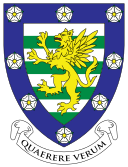Downing College
| Downing College | |
|---|---|
 |
|
 |
|
| University | Cambridge University |
| Location | Regent Street, Cambridge (map) |
| Motto | Quaerere Verum (Latin) |
| Motto in English | Seek the truth |
| Founder | Sir George Downing |
| Established | 1800 |
| Sister college | Lincoln College, Oxford |
| Master | Geoffrey Grimmett |
| Undergraduates | 403 |
| Postgraduates | 252 |
| Website | www |
| JCR | www |
| MCR | www |
| Boat club | www |
Downing College is a constituent college of the University of Cambridge, and currently has around 650 students. Founded in 1800, it was the only college to be added to Cambridge University between 1596 and 1869, and is often described as the oldest of the new colleges and the newest of the old.
The current Master of the college is Geoffrey Grimmett, Professor of Mathematical Statistics at the University.
Upon the death of Sir George Downing, 3rd Baronet in 1749, the wealth left by his grandfather, Sir George Downing, who served both Cromwell and Charles II and built 10 Downing Street (a door formerly from Number 10 is in use in the college), was applied by his will. Under this will, as he had no direct issue (he was legally separated from his wife), the family fortune was left to his cousin, Sir Jacob Downing, and if he died without heir, to three cousins in succession. If they all died without issue, the estates were to be used to found a college at Cambridge called Downing.
Sir Jacob died in 1764, and as the other named heirs had also died, the college should have come into existence then, but Sir Jacob's widow, Margaret, refused to give up the estates and the various relatives who were Sir George's legal heirs had to take costly and prolonged action in the Court of Chancery to compel her to do so. She died in 1778 but her second husband and the son of her sister continued to resist the heirs-at-law's action until 1800 when the Court decided in favour of Sir George's will and George III granted Downing a Royal Charter, marking the official foundation of the college.
The architect William Wilkins was commissioned by the trustees of the Downing estate, who included the Master of Clare College and St John's College and the Archbishops of Canterbury and York, to design the plan for the college. Wilkins, a disciple of the neo-classical architectural style, designed the first wholly campus-based college plan in the world based on a magnificent entrance on Downing Street reaching back to form the largest court in Cambridge, extending to Lensfield Road. But this was not to be.
...
Wikipedia
